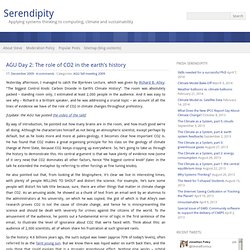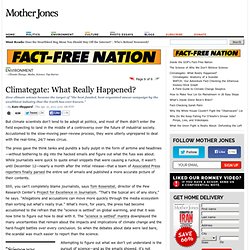

AGU Day 2: The role of CO2 in the earth’s history. Yesterday afternoon, I managed to catch the Bjernes Lecture, which was given by Richard B.

Alley: “The biggest Control Knob: Carbon Dioxide in Earth’s Climate History”. The room was absolutely packed – standing room only, I estimated at least 2,000 people in the audience. And it was easy to see why – Richard is a brilliant speaker, and he was addressing a crucial topic – an account of all the evidence we have of the role of CO2 throughout prehistory. By way of introduction, he pointed out how many brains are in the room, and how much good we’re all doing. Although he characterizes himself as not being an atmospheric scientist, except perhaps by default, but as he looks more and more at paleo-geology, it becomes clear how important CO2 is. He also pointed out that, from looking at the blogosphere, it’s clear we live in interesting times, with plenty of people WILLING TO SHOUT and distort the science.
But can we demonstrate it? The Discovery of Global Warming - A History. How long have we known? I’m giving a talk today to a group of high school students.

Most of the talk focusses on climate models, and the kinds of experiments you can do with them. But I thought I’d start with a little bit of history, to demonstrate some key points in the development of our understanding of climate change. Here’s some of the slides I put together (drawing heavily on Spencer Weart’s the Discovery of Global Warming for inspiration). Comments on these slides are welcome. I plan to start with this image: …and ask some general questions like: What do you think of when you see this image? For millions of years, the planet had a natural control system that kept the climate relatively stable. I then show some graphs showing temperature changes through pre-history, together with graphs of the recent temperature rise. KQED's multimedia series providing in-depth coverage of climate-related science and policy issues from a California perspective.
Move forms California’s largest science & environmental unit for electronic media Keven Guillory Climate Watch Sr.

Editor Craig Miller with Producer Molly Samuel in the KQED studios. After four years, numerous awards, and something just shy of 900 blog posts, the multimedia reporting effort that’s been known as Climate Watch is turning a significant page. KQED is combining our efforts with Quest, the station’s more broadly-based science and environmental news and programming effort.
We’ll continue to cover climate-related issues, as evidenced by the recent rollout of Heat and Harvest, a major multimedia project with the combined resources of Climate Watch, Quest and the Center for Investigative Reporting. California’s heat wave came late and is staying late Craig Miller Sunset on San Pablo Bay. The Great American Heat Wave of 2012 arrived later in California than in many parts of the country — and it’s in no hurry to leave. Bodega Marine Lab / UC Davis By Nicholas Christen and Craig Miller. Climate Change. 350.org. Connect the Dots. TreeHugger. We Are Power Shift. Links related to “Power Shift,” a special edition of Grist. Climategate: What Really Happened? But climate scientists don't tend to be adept at politics, and most of them didn't enter the field expecting to land in the middle of a controversy over the future of industrial society.

Accustomed to the slow-moving peer-review process, they were utterly unprepared to deal with the real-time, 24/7 news circus. The press gave the think tanks and pundits a bully pulpit in the form of airtime and headlines—without bothering to dig into the hacked emails and figure out what the fuss was about.
While journalists were quick to quote email snippets that were causing a ruckus, it wasn't until December 12—nearly a month after the initial release—that a team of Associated Press reporters finally parsed the entire set of emails and published a more accurate picture of their contents. Still, you can't completely blame journalists, says Tom Rosenstiel, director of the Pew Research Center's Project for Excellence in Journalism.
"That's the typical arc of any story," he says.